Turkey Profile
Turkeys do not get the respect they deserve. Aside from being one of the most farmed birds, they also have a bunch of negative phrases named after them. Cold turkey, jive turkey, and talk turkey, to name a few. And being called a turkey isn’t exactly a compliment, either.
And the casual oversight for the poor turkey hasn’t gotten any better since then. Hunted to almost extinction, this excellent bird is still on the road to recovery.
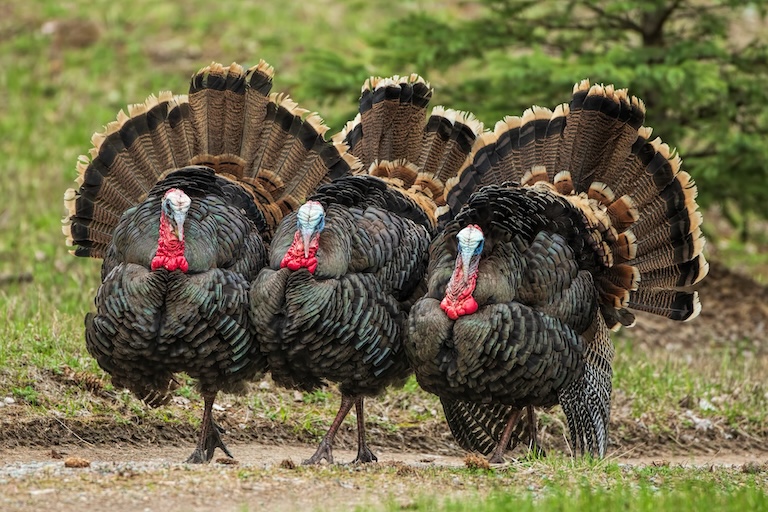
Turkey Facts Overview
| Habitat: | Forests |
| Location: | North America, Yucatan Peninsula |
| Lifespan: | 12+ years |
| Size: | Up to 1.2m (4ft) tall |
| Weight: | Wild turkeys up to 11kg (24 lb) Ocellated turkey up to 5kg (11lb) |
| Colour: | Grey/brown to vibrant blues and oranges |
| Diet: | Gains, seeds, invertebrates, lizards, fruits, |
| Predators: | Humans, coyotes, wolves, |
| Top Speed: | 89km/h (55 mph) |
| No. of Species: | 2 |
| Conservation Status: | Least concern, Near Threatened (Ocellated turkey, IUCN) |
Turkeys make up two species: the smaller, ocellated turkey from the Yucatan Peninsula, and the ironically-names wild turkey from farther North that has been domesticated.
They’re big, powerful Galliformes with some incredible colouration and remarkable appendages. They aren’t all that smart but they’re tough, and they keep order very strictly within their groups.
They’re faster than you might expect, but this has not saved them from abuse at the hands of hunters, and, far worse, the industrial farming complex.
Interesting Turkey Facts
1. They’re fowl
This is not an insult, turkeys are a sur[prising members of ground-dwelling Galliformes, in the same family as the chickens, pheasants and peacocks, and reasonably closely related to grouse.
This is a pretty new discovery, as they were previously thought to be part of their own separate family, but genomic analysis shows them to be members of the chicken family. 1
2. They have excellent vision
Turkeys see in high-quality colour and have three times the daytime vision of a human. On top of this, with eyes on the side of their heads, they get a field of view more than twice that of ours. Turkeys can see 270 degrees around them. 2
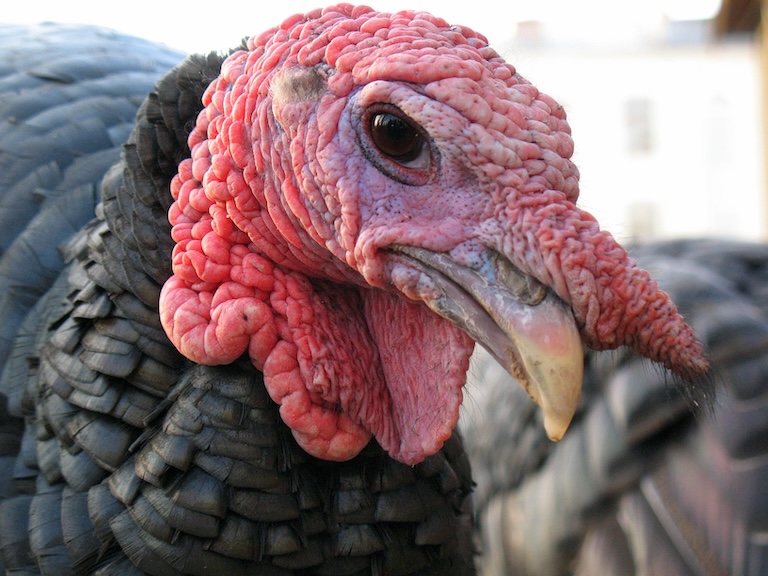
3. They’re surprisingly fast
Turkeys are pretty big as far as ground birds go. In fact, they’re one of the largest. But this doesn’t stop them from being surprisingly nimble on their feet. Wild turkeys are good runners, and while claims of their top speeds are wildly variable and unsourced, they do appear to be able to run at up to 29 km/h or 18mph.
They can also fly, and it’s said they can at least double this speed in the air. 3 4
4. The females like a long snood
Male turkeys are well known to be ugly, wrinkly birds, but the fleshy appendages on their faces play a significant role in mating.
Turkeys have wattles, that hand down, and snoods, that protrude from their foreheads. This snood is erectile, and when the turkey gets excited, it swells up with blood. The wattle hangs from the beak and plays a similar role.
Females prefer a male with a big snood, and males will defer to the one with the largest appendage. The size of this snood is a health indicator, and reflects the strength of the bird’s immune system, suggesting that it will be carrying good genes.
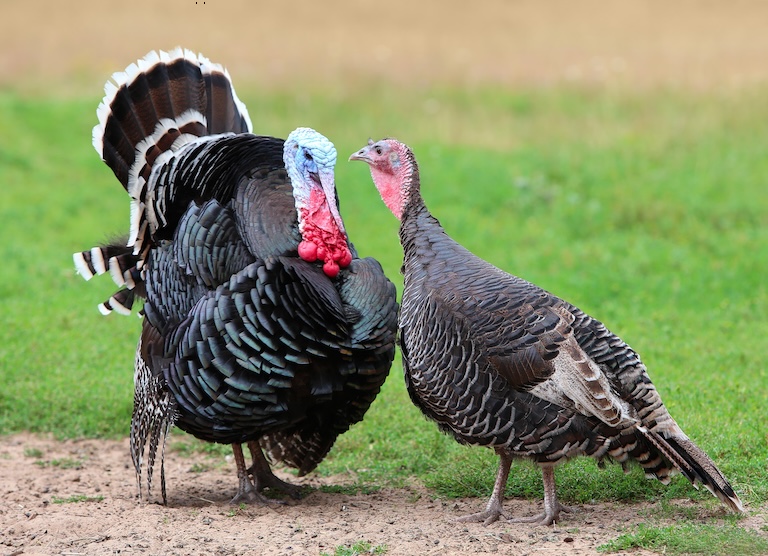
5. They attack people
As large Galliformes, turkeys have the power to be quite rough when they want to be. In their social circles, their pecking order is maintained very physically, and some turkeys extend this to humans and other animals, too.
Attacks are unlikely to be dangerous to a healthy human being, but much in the same way geese can be very persuasive, turkeys are capable of fighting people into falling over and injuring themselves.
6. You can tell them from their poop
If you’re only dealing with the droppings, you can still tell a fair bit about turkeys from their poop. Male droppings are shaped like the letter J, and that of the females is spiralled. They get thicker as the bird ages, so you can also get an idea of how mature the bird is from its droppings, too. 5
7. They’re not from Turkey
The word Turkey is related to the country, and the country certainly came first. Nobody’s entirely sure why these birds were named turkeys when they’re native to North America, but it’s possible that they arrived in Europe via Constantinople or were domesticated in that region and therefore associated with it.
Regardless, this bird has a long history of domestication and the corresponding exploitation that comes with it.
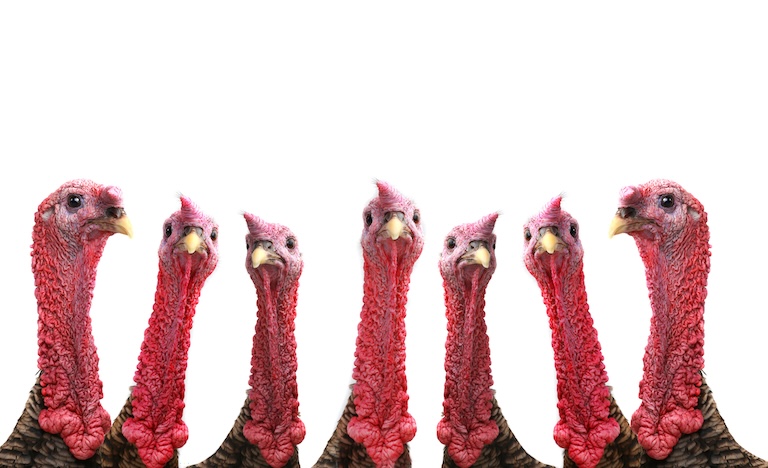
8. They have been abused
In classic coloniser fashion, the early European settlers set to work eradicating all native life on the North American continent. From the 17th to the 20th Century, wild turkey populations went the way of the native tribespeople and were slaughtered within an inch of their existence.
From an estimated 10 million birds, there were 30,000 remaining by 1930. Biologists came to the rescue as always, rounding up wild animals and redistributing them to states where they had gone extinct.
9. They’re not out of the woods yet
The wild turkey population is still declining slowly. Turkey hunting is a powerful driver of this decline, as is widespread clearing of their habitats.
The ocellated turkey, the Southernmost and smaller species is now listed as Vulnerable by the IUCN. But even the domesticated breed doesn’t have it all that great.
10. They’re farmed in abhorrent conditions
While the wild turkey is of Least Concern by conservation standards, the same can’t be said for their wellbeing. Turkey farming is notoriously cruel, and investigations always unearth unspeakable conditions for animals farmed so intensively.
Many farmed birds have horrific health conditions, are kept among the rotting bodies of their peers, are not cleaned out properly, and are even deliberately abused by farmers who suffer botched killing jobs at the slaughterhouse. Birds who are not killed properly on the line end up being boiled alive as their bodies enter the hot water vats to soften the feathers for plucking.
This is not a problem that’s unique to turkeys, in fact, it is inherent to the industrial farming system, but turkeys seem to be much more of an afterthought than many other livestock breeds.
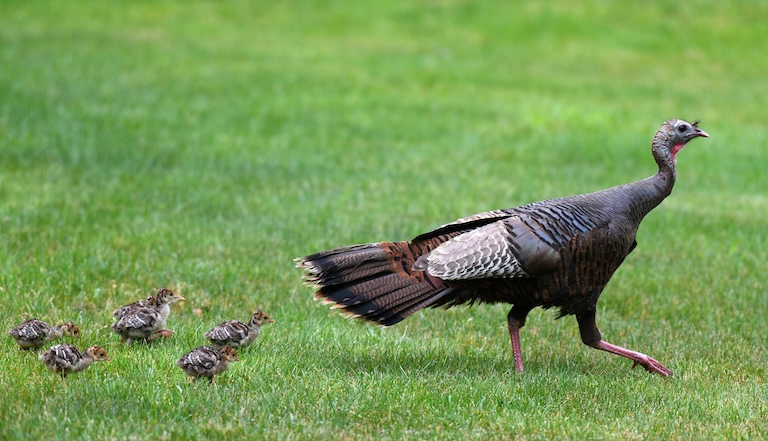
Turkey Fact-File Summary
Scientific Classification
| Kingdom: | Animalia |
| Phylum: | Chordata |
| Class: | Aves |
| Order: | Galliformes |
| Family: | Phasianinae |
| Genus: | Meleagris |
Fact Sources & References
- Rami A. Dalloul (2010), “Multi-Platform Next-Generation Sequencing of the Domestic Turkey (Meleagris gallopavo): Genome Assembly and Analysis”, PubMed Central.
- (2023), “What’s the difference between domesticated and wild turkeys?”, South Carolina Department of Natural Resources.
- Terry Ouderkirk (2019), “How Fast Can a Turkey Run”, YouTube.
- Cape Cod Times (2001), “Wild turkeys fly!”, YouTube.
- Susan Morse, “Wild Facts About Wild Turkeys”, U.S. Fish & Wildlife Service.
